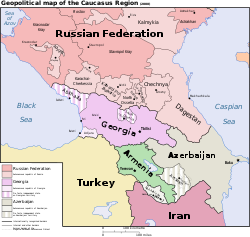This article has multiple issues. Please help improve it or discuss these issues on the talk page. (Learn how and when to remove these messages)
|




The history of the Caucasus region may be divided by geography into the history of the North Caucasus (Ciscaucasia), historically in the sphere of influence of Scythia and of Southern Russia (Eastern Europe), and that of the South Caucasus (Transcaucasia; Caucasian Albania, Georgia, Armenia, Azerbaijan) in the sphere of influence of Persia, Anatolia, and (for a very brief time) Assyria.
Throughout history, Southern Caucasus and parts of the North Caucasus have come under the control of various empires, including the Achaemenid, Neo-Assyrian Empire,[1] Parthian, Roman, Sassanian, Byzantine, Mongol, Ottoman, and successive Iranian (Safavid, Afsharid, and Qajar). In 1813 and 1828 by the Treaty of Gulistan and the Treaty of Turkmenchay respectively, Qajar Iran officially ceded its territories in the Caucasus in what is now Dagestan, eastern Georgia, Azerbaijan, and Armenia to the Russian Empire.[2] Russia conquered and annexed the rest of the North Caucasus in the course of the 19th century in the Caucasian Wars (1817–1864).
The North Caucasus became the scene of intense fighting during the Second World War. Nazi Germany attempted to capture the Caucasus region of Soviet Union in 1942 by a two-pronged attack towards both the western bank of the Volga (intended to seize the city of Stalingrad) and southeast towards Baku, a major center of oil production. Some parts of the North Caucasus fell under German occupation, but the Axis invasion eventually faltered as it failed to accomplish either goal, and Soviet soldiers drove the Germans back west following the Battle of Stalingrad (1942–1943).
Following the dissolution of the Soviet Union at the end of the Cold War, Armenia, Azerbaijan, and Georgia became independent nations. The Caucasus region has become the setting of territorial disputes in the post-Soviet era, which lead to the establishment of unrecognized states of Artsakh, Abkhazia, and South Ossetia.
- ^ Grayson, Albert Kirk (1972). Assyrian Royal Inscriptions: Volume I. Wiesbaden: Otto Harrassowitz. p. 108.
- ^ Timothy C. Dowling Russia at War: From the Mongol Conquest to Afghanistan, Chechnya, and Beyond pp 728-730 ABC-CLIO, 2 dec. 2014.ISBN 978-1598849486